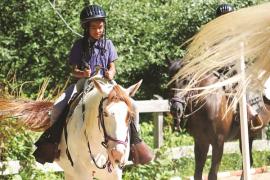It was 1995. TLC, Alanis Morissette, and Boyz II Men were riding high in the music charts. Apollo 13 and the original Toy Story were in the movie theaters. Michael Jordan made his return to the NBA. Bill Clinton was in the White House. And I was moving up, going from seasonal staff to full time at a camp.
With this new role came new responsibilities — as a supervisor, as a communicator, and as an educator. I no longer had the luxury of having the backup of a camp leadership team. I was now part of that camp leadership team.
My team was where the buck now stopped.
That same year was also the first time I heard the term “peer-to-peer abuse.” I remember sitting in a session at my first American Camp Association (ACA) National Conference and hearing that the ACA Camp Crisis Hotline had received several calls the previous summer about kids hurting other kids. Whether it was teasing, physical violence, hazing, bullying, or sexual abuse, I was hearing about behaviors and actions that had never occurred to me as being part of the camp experience. Naïve as it was, for me, camp had always been a place for kids to learn, grow, and thrive — not hurt each other.
Fast-forward almost 25 years, add a few gray hairs and a bit more experience, and I have lost much of that naiveté. But I’m just as disturbed. Cases of peer-to-peer abuse continue to occur at an alarming rate. The older and sometimes wiser me also has a much better understanding of the trauma and harm that this type of abuse can lead to.
As with any type of abuse to a child, the impact is multilayered. Campers can be emotionally and physically scarred and traumatized. A camp’s reputation can be equally damaged. In the era of #MeToo, it’s also important to note that peer-to-peer abuse can also become a threat to the financial health and reputation of a camp — and ultimately its viability. In one recent incident, two young campers were spotted on a bus using the cover of a towel, allegedly touching each other under their clothes. Despite the fact that staff spotted the incident, separated the campers, and reported what had happened immediately — they are now being sued by one of the parents for not preventing the incident from happening in the first place.
In another high-profile incident, Duke University was sued by parents for an alleged incident of peer-to-peer abuse that occurred between a group of boys, ages seven to ten, in an unsupervised cabin at a resident camp for chronically ill children. The camp was abruptly shut down shortly after this incident was discovered (Billman, 2019).
We have entered a time in which parent expectation is much higher, and public opinion for any type of abuse has become zero tolerance. At the end of the day, regardless of what “camper A did to camper B,” if abuse happens between campers at your camp, it is ultimately the camp’s responsibility. If a child is abused by another camper in your program, the first question that will always be asked is, “Where were the staff?” or “Who was taking care of my child when this happened?” Simply responding with “Kids will be kids,” or “They are just exploring” is no longer considered acceptable.
We need to use this threat as a motivation for change. The time to evaluate policies and practices is now, so there is no room for abuse to occur on our watch. First, however, we need to understand how abuse happens.
Understanding the Issue
Peer-to-peer abuse among campers can be opportunistic in nature, or it can occur when normal conflict between campers escalates to more damaging behaviors. Conflict between campers — and learning how to navigate that conflict — is an essential building block in the development of all youth. However, when campers start to use tools such as bullying and misplaced power and control to manage conflict, without staff intervention, this can sometimes lead to abusive behavior among peers.
Peer-to-peer abuse can include:
- Extreme bullying or hazing
- Abusive behaviors such as verbal, physical, or sexual abuse — and these can often escalate from one form to another
- Online or digital abuse or bullying (text, social media, etc.), or exposure to inappropriate materials (pornography, etc.)
- Interactions between campers of the same or different ages, and between individuals or groups
Just like adult-to-child abuse, peer-to-peer abuse can have a lasting, sometimes devastating, impact. From physical injuries to lifelong trauma, the experience of being abused can change lives forever.
Where and When Peer-to-Peer Abuse Happens
Reports and claims over the past 20 years have confirmed what many camp professionals know intuitively: peer-to-peer abuse thrives when campers have a sense of privacy and primarily during unstructured times. We know that peer-to-peer abuse occurs with more frequency during these times and places:
- First half hour and last half of the program day
- Transition times
- Dining hall and/or meal times
- All-camp activities
- Field trips
- Free choice or free time
- Bathrooms and/or shower houses
- Buses (transportation times)
- Cabins or other enclosed spaces when staff are not present
- Behind closed doors or curtains/sheets hanging in cabins
Common among all these times and places is the fact that there is an increased opportunity for seeking privacy as well as a likelihood that staff are either being asked to focus on several different things at one time, or simply fewer staff are present to manage a larger group of campers.
Supervision: How Is Just as Important as How Much
Many programs advertise that campers are supervised 100 percent of the time. While this sounds good in theory, it is very hard to achieve in reality. Yet, as society continues to place higher demands and expectations in terms of supervision, and as tightening labor markets make hiring and retention of staff a challenge, the issue is only likely to grow in importance.
Part of the solution may be in considering not just the quantity of the supervision, but also the quality. Are staff keeping kids engaged and involved? Do campers feel comfortable reaching out for help if they are experiencing abuse, or if they witness abuse by others? How well are staff and counselors communicating with each other about warning signs they may be seeing?
Engaged Supervision
Knowing what we know about when and where peer-to-peer abuse happens, we must train our staff to focus on and effectively manage times and locations when and where the risk of peer-to-peer abuse is highest. Engaged supervision is a critical camp component. At its heart, engaged supervision is about shifting the paradigm from watching campers to actively engaging and communicating with them so they stay engaged with you. This keeps staff attention on campers, and it prevents campers from seeking out other experiences or activities where inappropriate behavior or interactions may occur. It also allows staff to pay attention to subtle warning signs — tone of voice, coded conversations, body language — which might be missed if they are simply watching campers from afar.
Implementing an approach of engaged supervision involves three key components:
- Be involved, but don’t play to win. Sometimes the best way to keep children engaged is to participate in the activities. But it’s important to be clear about why you are there
- Keep the focus on the children and their experience, not yours.
- The primary role is still supervision — not playing or winning the game.
- Maintain proper ratios. Engaged supervision means having enough people to do the job effectively. It’s important to consider:
- If you or another staff person needs to leave the area (bathroom breaks, etc.), how is this communicated? Is extra coverage needed?
- How does your team communicate with leadership if ratios are not sufficient or you need help?
- Do ratios flex based on the needs of the campers?
- Positioned to supervise. Whether staff are part of the group (i.e., sitting within the circle) or watching a group, staff should be positioned to see and hear the children in their care. Staff should always:
- Have line of site.
- Be able to hear the tone and tenor of what is happening.
Zone Supervision
Lifeguards and waterfront teams have used zone supervision as a successful strategy for aquatic safety for years. How can we extrapolate this approach to all our camp activities? Whether staff are supervising a playground, sports field, cabin area at night, or the boundaries during an all-camp activity, it is important that everyone understand which “zones” or areas each person is responsible for.
- Consider making a map of the space that needs to be supervised. Post the map and train staff on the responsibilities involved for each zone.
- Have you validated zones by testing for ease of visibility and unexpected obstructions at different times of day and during different activities?
- How many staff are needed to supervise each zone? Some zones may need more or less staff depending on the nature of the activity or blind spots.
- Designate the best places to supervise from within each zone. If staff are getting involved with the activity in the zone, are they still able to properly supervise all the children present?
- How are staff expected to communicate during times of zone supervision? If there is an issue in one zone, how should that be communicated to staff in different zones?
Have You Assessed Your Camp? |
|
Understanding Blind Spots: A Call to Action
Whether they are literal or figurative, where are your blind spots when it comes to camper supervision?
Camps must be able to explain their approach to supervision to parents, campers, and staff. Should an incident of peer-to-peer abuse occur under your watch, you will be asked to explain your approach. Take time with your staff to assess any blind spots, consider a different approach, and update camp practices.
As camp professionals, we need to be able to demonstrate that we are keeping the campers in our care safe, engaged, and supported. Multiple steps can be taken to provide staff with tools to prevent peer-to-peer abuse in your camp programs. This can include guidance on conflict resolution, reflecting on your camp’s approach to behavior support, and empowering campers to build a culture of respect within your camp community. How your staff show up to support, manage, and supervise your campers is key to the success of any of these efforts regarding camper safety and abuse prevention. Supervision doesn’t have to be a hovercraft over every camper, but it does require that staff are present and engaged. This allows for staff to intervene when needed, guide when appropriate, and model expectations for campers.
Whether it occurred in 1995 or now, abuse between campers in our programs is not acceptable. Like so many camp professionals, I entered this profession out of love for seeing campers learn, grow, and thrive at camp. This goal and commitment have never changed. However, my insistence that we collectively work together to prevent abuse of any type at camp has only grown stronger. It is only by creating positive camp environments where there is zero tolerance for any form of abuse that we can ensure campers get the full benefit of a positive camp experience.
Further Reading |
Reference
Billman, J. C. (2019, January 29). Exclusive: Lawsuits accuse Duke University of concealing child sex abuse at its camp for chronically ill kids. Indy Weekly. Retrieved from indyweek.com/news/longform/exclusive-duke-university-camp-kaleidoscope-lawsuit-child-sexual-assault/
Katie Johnson works as a consultant for The Redwoods Group, a mission-driven social enterprise that uses insurance to prevent harm. Katie also served on the American Camp Association staff for eight years and was a camp director for Camp Fire Camps on the West Coast prior to that time. She can be reached via email at [email protected].


